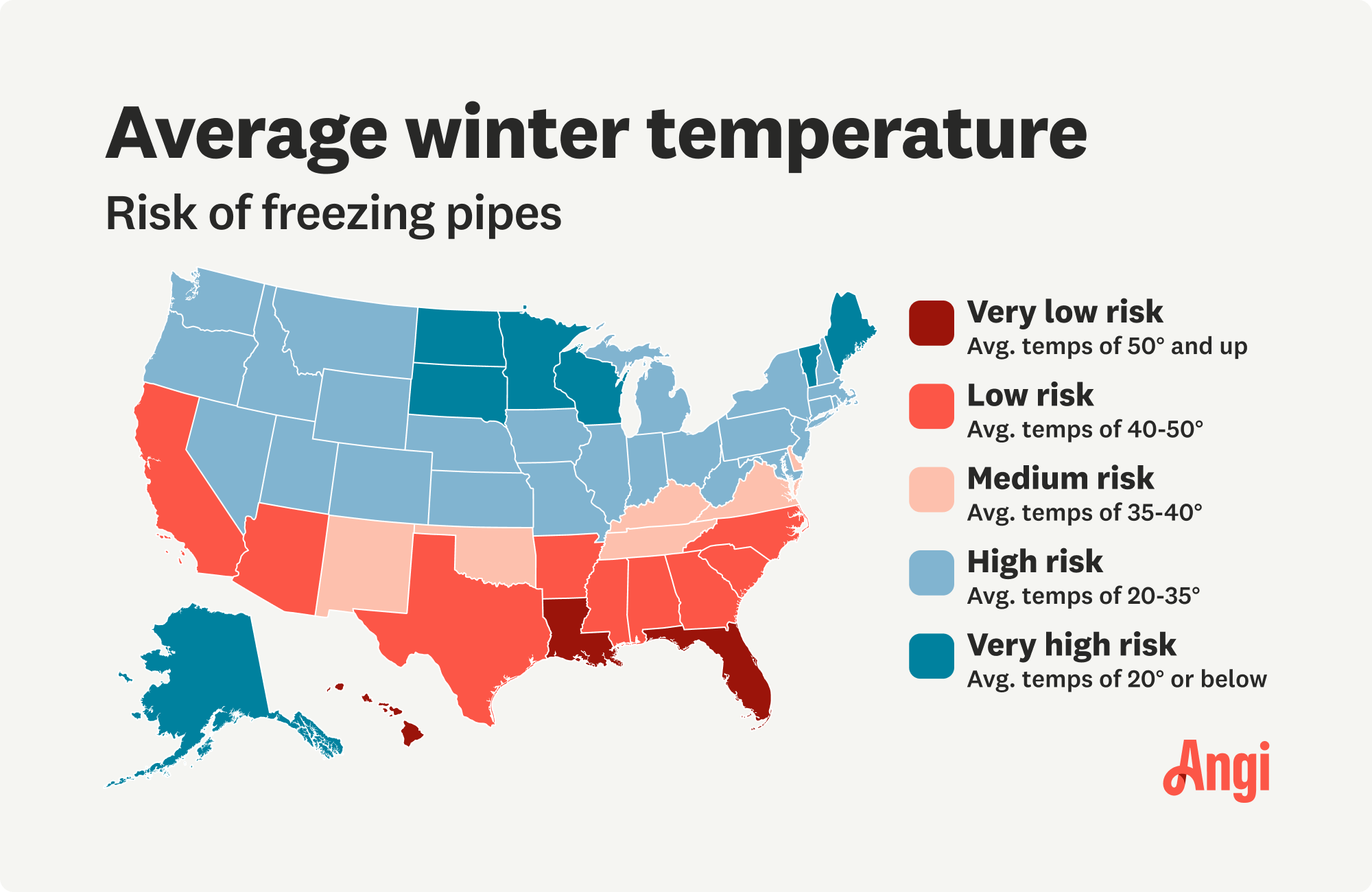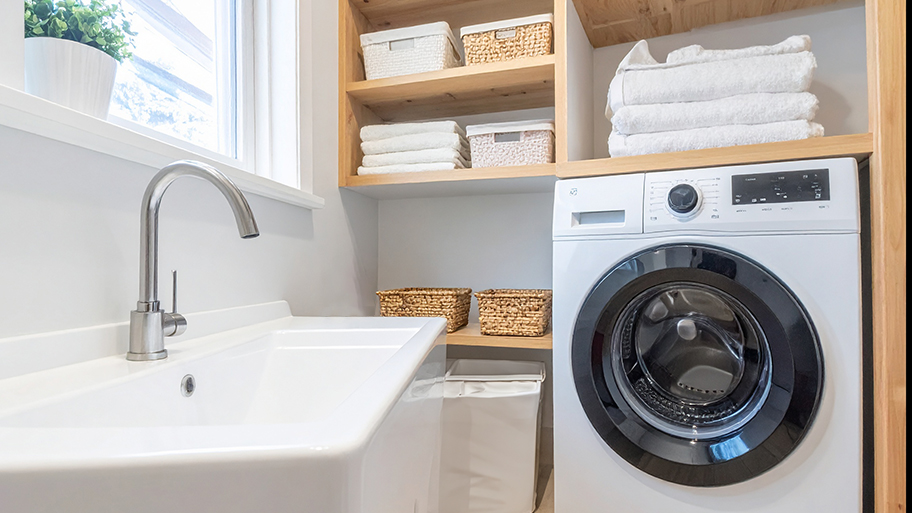
Repairing a main water line is an urgent matter, so use this guide to get an idea of how much main water line repairs cost to act fast.
When the temperature goes down, your sink can back up


Frozen water can clog your pipes and back up a sink drain.
When water in your pipes freezes, it can cause them to burst.
Debris from a garbage disposal can make a frozen clog worse.
Running boiling water down your pipes can help thaw them.
Repairing a burst pipe costs between $200 and $3,000.
Wintertime can mean a ton of fun in the snow, like impromptu sledding or snowball fights. However, it’s not fun when cold temperatures wreak havoc on your plumbing. Moisture in your pipes can freeze and cause blockages, backups, and damage. Here’s how these problems occur and what you can do to resolve them.
One of the laws of thermodynamics states that frozen liquids tend to expand. If you’ve accidentally left a bottle of water or juice in your freezer for too long, you’re already acquainted with the concept. So, when the temperature outside drops below freezing, any water or moisture in your pipes can freeze and solidify.
This issue is most common with pipes close to the exterior of your home and in unheated areas like the basement, garage, or attic. If the temperature drops enough, even indoor plumbing running through cabinets or interior walls can feel the bite of winter.
The problem doesn’t stop there because your pipes contain more than just water. Dirt, hair, oil, food particles, and other debris can end up going down your sink. When they mix with frozen water that expands, you can experience a nasty and stubborn clog.
When your pipes freeze, the water within them creates a near-solid barrier that prevents your sink from draining properly. This issue can lead to standing water or a worsening of the clog as more water freezes.
Clogs aren’t the only concern you’ll need to consider. Frozen water can rise in your pipes, pushing any debris out through your drain and causing a backup. This problem can be especially prevalent if your sink has a garbage disposal attached, as pulverized food waste can freeze solid and potentially damage the disposal as it backs up.
Water expands while it freezes, placing extreme strain on plumbing. The force of the expansion can cause frozen pipes to burst and lead to leaks, water damage, and a clogged sink.

It’s vital to know how to tell if pipes are frozen. By understanding the signs, you can hopefully address the problem before it progresses to the point of clogs or severe damage. And don’t neglect your interior pipes. Even pipes connecting to sinks nestled indoors can freeze.
If you experience a clogged sink in the winter, you have several options for dealing with the problem. The first step is to run a pipe snake down your drain to rule out frozen water in the pipe or a normal debris buildup. If there’s no hair or food stuck to the inserted end of the snake, ice is likely causing the clog.
Next, locate the sink’s shut-off valve and turn it off. If your shut-off valve for the sink is frozen, you’ll have to troubleshoot it. A rapid thaw can release pressure from your pipe, exposing cracks or burst sections that a sheet of ice kept from leaking. After shutting off the water, take the following steps to deal with frozen sink pipes.
In the event of a plumbing emergency, it is critical to know the location of your water main shut-off valve in case you need to quickly stop water from flowing into your home. If you are unsure, a pro can help you locate the valve and show you how to operate it.
The most common solution to a pipe with a backup of frozen water is to slowly pour hot water down the drain. Hot water should melt away the ice and thaw the obstruction enough to clear your sink pipes.
Note: Before running hot water down your drain, check the material of your pipes. Plastic or polyvinyl chloride (PVC) pipes can warp or even melt when they come into contact with hot water. If your pipes are PVC, consider using another method, or exercise extreme care with heated water.
Try to run a hose or funnel as far down your drain as possible before pouring or running the hot water down it. Doing so will help ensure that the water doesn’t come into contact with cold pipes and lose most of its heat before getting to the clogged area.
If you know the location of the frozen clog in your pipes and can access that section, you can directly thaw the area. Wrap a heavy towel around the pipe to hold heat in, then pour hot water directly onto the towel, using a bucket to catch the runoff. For a cleaner method of heating your pipes, you can use a hair dryer on high heat or an infrared heat lamp.
If you have polyvinyl chloride (PVC) pipes, we recommend caution when heating them. Overheated PVC may expand or even melt. In addition, PVC gives off hazardous fumes when heated to 158 degrees Fahrenheit or higher. Be sure to monitor the thawing process closely.
No matter what material your pipes consist of, you should never use a blowtorch or other open flame to thaw them. At best, the intense heat will weaken your pipes. At worst, you’ll cause them to burst immediately.
Call a local plumber to resolve the issue if none of the above methods work. A licensed plumber can help you find and identify a frozen section of your pipe, especially if you can’t access it or don’t know what to look for. If your pipe bursts and you need professional help, the cost of repairing a burst pipe averages $200 to $3,000.
You can take measures to keep your water running freely through your pipes during the winter and prevent freezing. Though some of these methods may require you to be less conservative about your use of water and heat, an ounce of prevention is worth a pound of cure.
For pipes in unheated areas, try to keep doors, windows, and other entrances or exits closed off. Seal garages, attics, and basements against the cold as much as possible. That also means installing insulation in drafty areas like crawl spaces and around your home’s foundation.
Keep cabinets open to allow warm air to circulate around your pipes. If you have pets or children, move chemicals or cleaners you store in these cabinets to a safe location.
Drip your faucets at a steady but constant pace. Water running continuously through the pipe will help prevent freezing. If you have a garbage disposal, run cold water to prevent fats and starches from breaking down and sticking to the interior of your pipes.
The temperature at which pipes freeze is below 32 degrees, but set your heat to at least 55 degrees to help protect interior pipes and compensate for cooler areas. The map below shows how at risk you are for frozen pipes depending on your state.

From average costs to expert advice, get all the answers you need to get your job done.

Repairing a main water line is an urgent matter, so use this guide to get an idea of how much main water line repairs cost to act fast.

The cost to add plumbing to a detached garage depends on several factors, including the type of plumbing and the garage's distance from your home.

Discover the average water tank cost, including installation, maintenance, and tips to save. Get transparent pricing and expert advice for your home project.

Extend the life of your appliances by installing a water pressure regulator—here is why this valve is essential in your home.

Weak water pressure, chipped hardware, and drainage problems are signs that it’s time to replace your bathroom plumbing.

If your bathtub is leaking from underneath, there are a few things to check to find the source and get a permanent fix in place to minimize water damage.